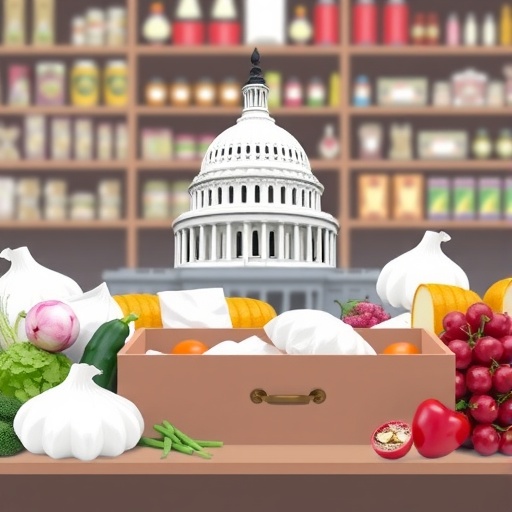SNAP benefits on the Chopping Block: Government Shutdown Looms to Halt Food Assistance for Millions by November 1
In a stark warning that has sent shockwaves through low-income communities across the nation, several states have announced they may suspend SNAP benefits as early as November 1, 2023, due to the escalating government shutdown. This impending crisis threatens to strip food assistance from over 40 million Americans who depend on the Supplemental Nutrition Assistance Program (SNAP) to put meals on the table, exacerbating hunger at a time when inflation is already squeezing household budgets.
- States Issue Dire Alerts: SNAP Suspension Looms for 10 Million Recipients
- Families Feel the Squeeze: Real Stories Behind the SNAP Crisis
- Political Standoff Fuels Shutdown: Why Federal Funding for SNAP is in Jeopardy
- Beyond SNAP: Wider Repercussions for Federal Programs and Economy
- Pathways to Resolution: Congress Races Against November Deadline
The November deadline stems from depleted federal funding reserves, as the ongoing political impasse in Washington D.C. grinds essential federal programs to a halt. Officials in states like California, New York, and Texas have issued urgent alerts, estimating that without immediate congressional action, benefit cards could go empty, leaving families scrambling for alternatives amid rising grocery prices.
States Issue Dire Alerts: SNAP Suspension Looms for 10 Million Recipients
As the government shutdown drags into its second week, state agencies responsible for administering SNAP benefits are sounding the alarm. California’s Department of Social Services, which oversees SNAP for nearly 5 million residents, released a statement on October 15, 2023, warning that “without renewed federal appropriations, we will be compelled to pause benefit issuances starting November 1.” This would impact an estimated 10 million people nationwide in the first wave of suspensions, according to preliminary figures from the U.S. Department of Agriculture (USDA).
New York Governor Kathy Hochul echoed these concerns during a press conference in Albany, stating, “This isn’t just about paperwork—it’s about families who rely on food assistance to survive. A shutdown could mean empty pantries for millions of New Yorkers by the November deadline.” The Empire State, home to over 3 million SNAP participants, faces particular vulnerability due to its high urban poverty rates. Similarly, Texas officials reported that their state’s 4.5 million beneficiaries could see disruptions, with rural areas hit hardest where food deserts already limit access to affordable groceries.
These warnings aren’t hyperbole. During the 2018-2019 shutdown, which lasted 35 days, SNAP experienced temporary delays, but current projections suggest a more severe fallout. The USDA’s contingency plans allow states to use state funds for up to 30 days, but with federal programs frozen, many governors are already tapping emergency reserves, straining budgets further amid post-pandemic recovery efforts.
- California: 5 million affected; potential $1.2 billion monthly loss in benefits.
- New York: 3.2 million recipients; urban centers like NYC at highest risk.
- Texas: 4.5 million enrollees; rural counties face immediate shortages.
- Florida: 4 million impacted; hurricane recovery zones doubly vulnerable.
Experts at the Center on Budget and Policy Priorities (CBPP) warn that the ripple effects could extend beyond November, potentially leading to a backlog of claims and administrative chaos if the shutdown persists.
Families Feel the Squeeze: Real Stories Behind the SNAP Crisis
For many Americans, SNAP benefits aren’t a luxury—they’re a lifeline. Take Maria Gonzalez, a single mother of three in Los Angeles, who spoke to reporters outside a local food bank on October 20, 2023. “I use my EBT card every week to buy milk and bread for my kids. If it stops on November 1, I don’t know what we’ll do. Groceries are already up 20% this year,” she shared, her voice trembling as she described rationing portions to make ends meet.
Gonzalez’s story is emblematic of the human toll. SNAP, formerly known as food stamps, provides an average of $250 per household monthly, helping to combat food insecurity that affects 13.5% of U.S. households, per 2022 USDA data. In the wake of the COVID-19 pandemic, enrollment surged to record highs, with participation rates climbing 50% in some states. Now, the government shutdown risks undoing these gains, particularly for vulnerable groups like children, seniors, and working poor families.
In Detroit, Michigan, where unemployment lingers above the national average, community organizers are mobilizing. Reverend James Carter of the Detroit Food Justice Network told our team, “We’ve seen lines at soup kitchens double during past shutdowns. With the November deadline approaching, we’re preparing for a surge that could overwhelm our resources. Food assistance programs like SNAP are the safety net—pull it away, and people fall through.” Statistics bear this out: A 2023 Feeding America report projects that a full SNAP suspension could increase child hunger by 15%, affecting 5 million kids nationwide.
Moreover, the economic fallout extends to grocery retailers. Chains like Walmart and Kroger, which redeem billions in SNAP dollars annually, could lose up to $5 billion in sales if benefits halt, according to the Food Marketing Institute. This creates a vicious cycle, where reduced spending hits local economies hardest in food-insecure regions.
Political Standoff Fuels Shutdown: Why Federal Funding for SNAP is in Jeopardy
The root of this crisis lies in Washington, where partisan gridlock over spending bills has triggered the government shutdown. House Republicans, pushing for deeper cuts to federal programs, have blocked a bipartisan continuing resolution, demanding concessions on issues like border security and debt ceiling reforms. Senate Democrats, led by Majority Leader Chuck Schumer, have accused the GOP of “holding American families hostage,” as Schumer put it in a fiery floor speech on October 18, 2023.
At the heart of the dispute is the Farm Bill, which funds SNAP alongside agricultural subsidies. The 2018 Farm Bill extension expires at the end of September 2023, but without renewal, SNAP benefits face automatic reductions. The Congressional Budget Office (CBO) estimates that prolonged shutdown could slash SNAP funding by $10 billion in the first quarter alone, forcing states to either borrow or cut services.
Historical precedents paint a grim picture. The 1995-1996 shutdowns led to temporary SNAP halts in some areas, while the 2013 event delayed benefits for 500,000 recipients. This time, with inflation at 3.7% and food costs up 11% year-over-year (Bureau of Labor Statistics, September 2023), the stakes are higher. Advocacy groups like the National WIC Association are also raising alarms, as related federal programs for women, infants, and children could follow SNAP’s lead into suspension.
White House Press Secretary Karine Jean-Pierre addressed the issue on October 22, urging Congress to “prioritize the American people over politics. Food assistance should never be a bargaining chip.” Yet, with midterm election pressures mounting, analysts from Politico predict negotiations could stretch into December, pushing the November deadline into a full-blown emergency.
Beyond SNAP: Wider Repercussions for Federal Programs and Economy
The government shutdown‘s shadow looms large over more than just SNAP benefits. Other federal programs, including WIC, Head Start, and low-income housing assistance, are teetering on the edge. The USDA, which administers SNAP, operates with a workforce of 100,000; furloughs could delay not only benefit processing but also food safety inspections, potentially leading to supply chain disruptions.
Economically, the shutdown’s cost is staggering. A 2023 Government Accountability Office (GAO) study estimates each week of closure drains $1.5 billion from the U.S. economy, with food assistance cuts amplifying the pain in low-wage sectors. Food banks, already strained by a 25% demand increase since 2020 (per Feeding America), report stockpiling non-perishables but warn of shortages if SNAP fails.
In rural America, where SNAP comprises 15% of grocery spending, the impact could be devastating. States like Kentucky and Mississippi, with participation rates exceeding 20%, face compounded challenges from natural disasters and economic downturns. A joint report from the Brookings Institution highlights that “suspending SNAP benefits during a shutdown isn’t just a policy failure—it’s a humanitarian one, widening inequality gaps that have persisted for decades.“
Immigrant communities, often ineligible for full SNAP aid, are turning to nonprofits, but resources are finite. In Chicago, the Greater Chicago Food Depository has seen a 30% uptick in calls since the shutdown began, with director Kate Bordonaro noting, “We’re bridging gaps, but we can’t replace federal programs. The November deadline is a ticking clock for hunger.“
Pathways to Resolution: Congress Races Against November Deadline
As the November deadline approaches, glimmers of hope emerge from bipartisan talks. House Speaker Kevin McCarthy has scheduled emergency sessions for October 25, 2023, aiming to pass a short-term funding bill that would avert immediate SNAP benefits suspensions. Senate negotiators, including moderate Republicans like Susan Collins, are pushing for a compromise that protects essential federal programs while addressing fiscal concerns.
Advocacy efforts are intensifying. The National SNAP Coalition has launched a “Feed the Nation” campaign, urging citizens to contact lawmakers. Petitions have garnered over 500,000 signatures, and celebrity endorsements from figures like actress Viola Davis highlight the issue’s urgency: “Hunger doesn’t vote by party—neither should our safety nets.“
Looking ahead, experts predict that even if resolved, a partial shutdown could lead to administrative backlogs, delaying food assistance for weeks. Long-term, the Farm Bill’s reauthorization by 2024 offers a chance for SNAP enhancements, such as inflation-adjusted benefits or streamlined enrollment. The USDA is exploring state-federal partnerships to buffer future crises, but for now, families brace for uncertainty.
In the coming days, all eyes will be on Capitol Hill. A resolution before November 1 could save millions from hardship, but failure risks a hunger epidemic that echoes the Great Depression. As one policy analyst at the Urban Institute put it, “This shutdown tests our nation’s commitment to its most vulnerable. The clock is ticking.” With grocery lines lengthening and pantries emptying, the pressure mounts for leaders to act decisively.









